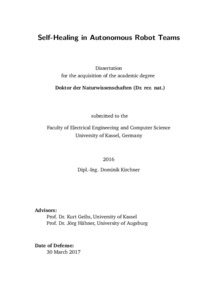| dcterms.abstract | Today, robots are used in nearly every type of automated manufacturing and assembly process. Robot installations typically apply static actuator systems in clearly structured environments. These systems show impressive abilities in speed and accuracy for repetitive manipulation tasks. Future automation applications, however, require an increasing level of flexibility, where classical systems reach their physical limits. As a reaction, robots become mobile, intelligent and cooperative. These new characteristics, however, introduce further challenges. Dependable operation, for example, is considered as a major issue. Currently achieved operation durations are often too short to meet real-world requirements. This qualifies their benefits and blocks wide-spread application. This thesis presents RoSHA (Robot Self-Healing Architecture), a comprehensive self-healing solution to improve the dependability of autonomous mobile robot teams. Our proposed self-healing approach combines an integrative design with sophisticated self-healing abilities. The design specially addresses flexibility and ease of integration. Up to our knowledge, this design is the first that allows already existing (multi-)robot systems to integrate self-healing without extensive system changes. The self-healing functionality itself follows the Autonomic Computing paradigm and is organized after the MAPE-K structure. Our realization uses an adaptive monitoring for comprehensive and efficient system observation. An individual model-based configuration allows tailored observation for each system component in order to minimize the computational overhead. For failure detection and diagnosis, we present QBFD (Qualitative Bayesian Failure Diagnosis). QBFD provides the ability to cope with specific challenges of the robotic domain, like noisy and incomplete observations or imprecise knowledge of the systems dynamics and achieves highly reliable and efficient estimation of the failure condition. Our failure recovery mechanism is adopted from a robot behavior control language to specify architectural adaptations for coordinated multi-robot recovery. This constitutes a novel way to model cooperative recovery for multi-robot systems. All components are developed on the basis of a formal robot model. Up to our knowledge, this is the first formalization of commonly accepted dependability concepts. Finally, we present an evaluation of our approach in a comprehensive case study. We choose the domain of cooperative driving for a challenging and realistic evaluation scenario. The case study reviews the viability of our self-healing solution in different ways, where we analyze the achievable application performance gain and the self-healing quality. A non-exhaustive cross-validation confirms a significant improvement of application performance and availability with reasonable reactivity. Therefore, we are confident that our proposed solution considerably improves dependable operation for teams of autonomous mobile robots. | eng |

